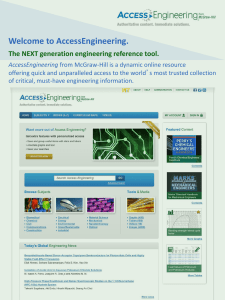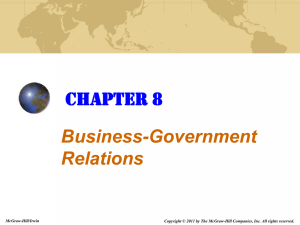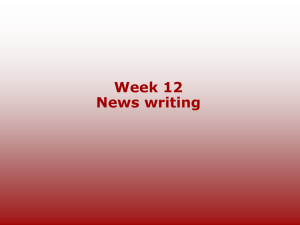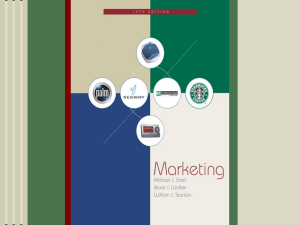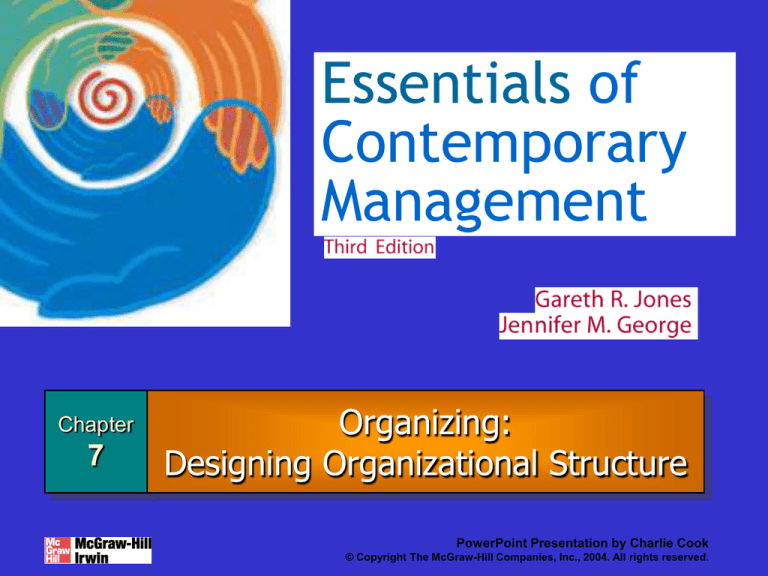
Essentials of
Contemporary
Management
Chapter
7
Organizing:
Designing Organizational Structure
PowerPoint Presentation by Charlie Cook
© Copyright The McGraw-Hill Companies, Inc., 2004. All rights reserved.
Learning Objectives
• After studying the chapter, you should be able to:
Identify the factors that influence managers’
choice of an organizational structure.
Explain how managers group tasks into jobs
that are motivating and satisfying for employees.
Describe the types of organizational structures
managers can design, and explain why they choose
one structure over another.
Explain why there is a need to both centralize
and decentralized authority.
© Copyright 2004 McGraw-Hill. All rights reserved.
7–2
Learning Objectives (cont’d)
Explain why managers must coordinate and
integrate between jobs, functions, and divisions
as an organization grows.
Explain why managers who seek new ways to
increase efficiency and effectiveness are using
strategic alliances and network structures.
© Copyright 2004 McGraw-Hill. All rights reserved.
7–3
Organizational Structure
• Organizational Architecture
The organizational structure, control systems,
culture, and human resource management systems
that together determine how efficiently and
effectively organizational resources are used.
© Copyright 2004 McGraw-Hill. All rights reserved.
7–4
Designing Organizational Structure
• Organizing
The process by which managers establish working
relationships among employees to achieve goals.
• Organizational Structure
Formal system of task and reporting relationships
showing how workers use resources.
• Organizational design
The process by which managers make specific
choices that result in a particular kind of
organizational structure.
© Copyright 2004 McGraw-Hill. All rights reserved.
7–5
Factors Affecting Organizational Structure
Figure 7.1
© Copyright 2004 McGraw-Hill. All rights reserved.
7–6
Determinants of Structure
• The Organizational Environment
The quicker the environment changes, the more
problems face managers.
Structure must be more flexible (i.e., decentralized
authority) when environmental change is rapid.
© Copyright 2004 McGraw-Hill. All rights reserved.
7–7
Determinants of Structure
• Strategy
Different strategies require the use of different
structures.
• A differentiation strategy needs a flexible structure,
low cost may need a more formal structure.
• Increased vertical integration or diversification also
requires a more flexible structure.
Chandler: Structure follows strategy
Corporate/
Business
Entities
工欲善其事必先利其器
© Copyright 2004 McGraw-Hill. All rights reserved.
7–8
Determinants of Structure
• Technology
The combination of skills, knowledge, tools,
equipment, computers and machines used in the
organization.
More complex technology makes it harder for
managers to regulate the organization.
• Organizations utilizing complex technology require a
flexible structure to be managed efficiently.
• Organizations utilizing routine technology can be
more readily managed using a formal structure.
• Organizations with high employee interaction
requirements need a flexible structure.
© Copyright 2004 McGraw-Hill. All rights reserved.
7–9
Types of Technology
• Small Batch Technology
Small quantities of one-of-a-kind products are
produced by the skills of the workers who work
together in small groups.
• Appropriate structure is decentralized and flexible.
• Mass Production Technology
Automated machines that are programmed to make
high volumes of standard products.
• Formal structure is the best choice for workers who
must perform repetitive tasks.
© Copyright 2004 McGraw-Hill. All rights reserved.
7–10
Determinants of Structure
• Human Resources
Highly skilled workers whose jobs require working
in teams usually need a more flexible structure.
Higher skilled workers (e.g., CPA’s and doctors)
often have internalized professional norms.
• Managers must take into account all four
factors (environment, strategy, technology and
human resources) when designing the
structure of the organization.
© Copyright 2004 McGraw-Hill. All rights reserved.
7–11
Organization Structure Issues
• How to group tasks into individual jobs.
• How to group jobs into functions and divisions.
• Coordinating functions and divisions.
• Allocating authority.
• Types of integrating mechanisms.
© Copyright 2004 McGraw-Hill. All rights reserved.
7–12
Grouping Tasks Into Jobs: Job Design
• Job Design
The process by which managers decide how to divide
tasks into specific jobs.
Enhance specification and
• Division of Labor
independence
Splitting the work to be performed into particularly
impersonal tasks and assigning tasks to individual workers.
The appropriate division of labor results in an effective
and efficient workforce.
Internal cohesion and
• Job Simplification
external decoupling
Reducing the tasks each worker performs: too much
simplification results in boredom.
© Copyright 2004 McGraw-Hill. All rights reserved.
7–13
Job Design
• Job Enlargement
Increase the width of task
Increasing the number of tasks for a given job by
changing the division of labor.
The intention is to reduce boredom and fatigue by
increasing variety of tasks performed.
• Job Enrichment
Increase the depth of task
Increasing the degree of responsibility a worker has
over a job.
• Intended to increase worker involvement and selfdiscretion.
• Requires a flexible organizational structure to allow
employees to act flexibly and creatively.
© Copyright 2004 McGraw-Hill. All rights reserved.
7–14
The Job Characteristics Model
Source: Adapted from J. R. Hackman and G. R. Oldham,
Work Redesign (Reading, MA: Addison-Wesley, 1980).
© Copyright 2004 McGraw-Hill. All rights reserved.
Figure 7.2
7–15
Job Characteristics Model
Job Characteristic
Skill variety
Employee uses a wide range of skills.
Task identity
Worker is involved in all tasks of the job
from beginning to end of the production
process
Task significance
Worker feels the task is meaningful to
organization.
Autonomy
Employee has freedom to schedule tasks
and carry them out.
Feedback
Worker gets direct information about how
well the job is done.
© Copyright 2004 McGraw-Hill. All rights reserved.
7–16
Grouping Jobs into Functions
• Functional Structure
An organizational structure composed of all the
departments that an organization requires to
produce its goods or services.
Advantages
• Encourages learning from others doing similar jobs.
• Easy for managers to monitor and evaluate workers.
Disadvantages
• Difficult for departments to communicate with others.
• Preoccupation with own department and losing sight
of organizational goals.
© Copyright 2004 McGraw-Hill. All rights reserved.
7–17
The
Functional
Structure of
Pier 1
Imports
Figure 7.3
© Copyright 2004 McGraw-Hill. All rights reserved.
7–18
Divisional Structures
• Divisional Structure
An organizational structure composed of separate
business units within which are the functions that
work together to produce a specific product for a
specific customer.
• Divisions create smaller, manageable parts of a firm.
• Divisions develop a business-level strategy to
compete.
• Divisions have marketing, finance, and other
functions.
• Functional managers report to divisional managers
who then report to corporate upper management.
© Copyright 2004 McGraw-Hill. All rights reserved.
7–19
Types of Divisional Structures
• Product Structure
Customers are served by self-contained divisions
that handle a specific type of product or service.
• Allows functional managers to specialize in one
product area.
• Division managers become experts in their area.
• Removes need for direct supervision of division by
corporate managers.
• Divisional management improves the use of
resources.
© Copyright 2004 McGraw-Hill. All rights reserved.
7–20
Types of Divisional Structures (cont’d)
• Geographic Structure
Each regional or a country or area with customers
with differing needs is served by a local selfcontained division producing products that best
meet those needs.
Global geographic structure
• Different divisions serve each world region when
managers find different problems or demands across
the globe.
• Generally, this structure is adopted when managers
are pursuing a multidomestic strategy.
© Copyright 2004 McGraw-Hill. All rights reserved.
7–21
Types of Divisional Structures (cont’d)
• Market (Customer) Structure
Each kind of customer is served by a selfcontained division
Global market (customer) structure
• Customers in different regions buy similar products so
firms can locate manufacturing facilities and product
distribution networks where they decide is best.
• Firms pursuing a global strategy will use this type of
structure.
© Copyright 2004 McGraw-Hill. All rights reserved.
7–22
Product,
Market, and
Geographic
Structures
Figure 7.4
© Copyright 2004 McGraw-Hill. All rights reserved.
7–23
Viacom’s 2001
Product
Structure
© Copyright 2004 McGraw-Hill. All rights reserved.
Figure 7.5
7–24
Global Geographic and Global Product Structures
© Copyright 2004 McGraw-Hill. All rights reserved.
7–25
Matrix Design Structure
• Matrix Structure
An organizational structure that simultaneously
groups people and resources by function and
product.
• Results in a complex network of superior-subordinate
reporting relationships.
• The structure is very flexible and can respond rapidly
to the need for change.
• Each employee has two bosses (functional manager
and product manager) and possibly cannot satisfy
both.
© Copyright 2004 McGraw-Hill. All rights reserved.
7–26
Matrix Structure
Figure 7.6a
© Copyright 2004 McGraw-Hill. All rights reserved.
7–27
Product Team Design Structure
• Product Team Structure
The members are permanently assigned to the
team and empowered to bring a product to market.
• Avoids problems of two-way communication and the
conflicting demands of functional and product team
bosses.
Cross-functional team is composed of a group of
managers from different departments working
together to perform organizational tasks.
© Copyright 2004 McGraw-Hill. All rights reserved.
7–28
Product Team Structure
Figure 7.6b
© Copyright 2004 McGraw-Hill. All rights reserved.
7–29
Coordinating Functions and Divisions:
Allocating Authority
• Authority
The power to hold people accountable for their
actions and to make decisions concerning the use
of organizational resources.
• Hierarchy of Authority
An organization’s chain of command, specifying the
relative authority of each manager.
• Span of Control: refers to the number of workers a
manager manages.
Authority vs. responsibility vs. accountability
© Copyright 2004 McGraw-Hill. All rights reserved.
7–30
Allocating Authority (cont’d)
• Span of Control
The number of subordinates who report directly to
a manager.
• Line Manager
Managers in the direct chain of command who have
authority over people and resources lower down.
Primarily responsible for the production of goods or
services.
• Staff Manager
Managers who are functional-area specialists that
give advice to line managers.
© Copyright 2004 McGraw-Hill. All rights reserved.
7–31
The Hierarchy
of Authority
and Span of
Control at
McDonald’s
Corporation
Figure 7.7
© Copyright 2004 McGraw-Hill. All rights reserved.
7–32
Tall and Flat Organizations
• Tall structures have many levels of authority
and narrow spans of control.
As hierarchy levels increase, communication gets
difficult, creating delays in the time being taken to
implement decisions.
Communications can also become garbled as it is
repeated through the firm.
• Flat structures have fewer levels and wide
spans of control.
Structure results in quick communications but can
lead to overworked managers.
© Copyright 2004 McGraw-Hill. All rights reserved.
7–33
Flat Organizations
Figure 7.8a
© Copyright 2004 McGraw-Hill. All rights reserved.
7–34
Tall Organizations
Figure 7.8b
© Copyright 2004 McGraw-Hill. All rights reserved.
7–35
The Minimum Chain of Command
• Managers should carefully evaluate:
Do the organization have the right number of
middle managers?
Can the structure be altered to reduce levels?
• Centralized and Decentralized of Authority
Decentralization puts more authority at lower levels
and leads to flatter organizations.
• Works best in dynamic, highly competitive
environments.
Stable environments favor centralization of
authority.
© Copyright 2004 McGraw-Hill. All rights reserved.
7–36
Internal coordination
Integrating Mechanisms
Figure 7.9
© Copyright 2004 McGraw-Hill. All rights reserved.
7–37
Externally cooperative linkage
Strategic Alliances and Network Structures
• Strategic Alliance
An agreement in which managers pool or share
firm’s resources and know-how with a foreign
company and the two firms share in the rewards
and risks of starting a new venture.
• Network Structure:
A series of strategic alliances that an organization
creates with suppliers, manufacturers, and
distributors to produce and market a product.
Network structures allow firms to bring resources
together in a boundary-less organization.
© Copyright 2004 McGraw-Hill. All rights reserved.
7–38
Homework 6
• Adam Smith, in his Wealth of Nations (Book 5,
Chapter 1, Part 3, Article 2), argued that
university teachers should not be paid salaries
but rather that they should have to rely on the
fees they can collect from the students they
teach. What would be the advantages of this
systems? What difficulties do you see with this
proposal to pay piece rates to faculty?
© Copyright 2004 McGraw-Hill. All rights reserved.
7–39

